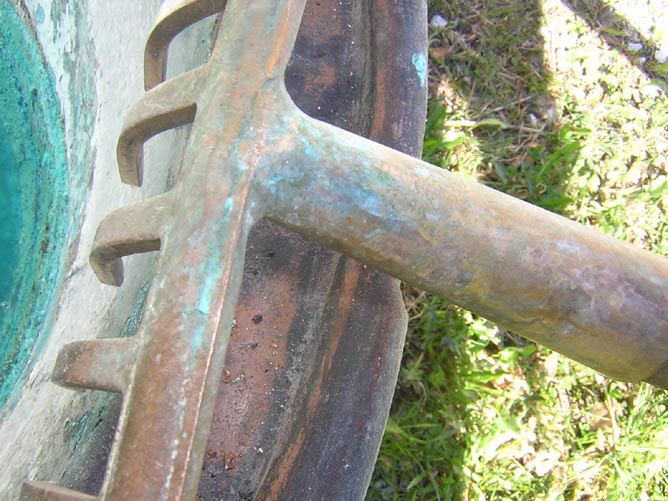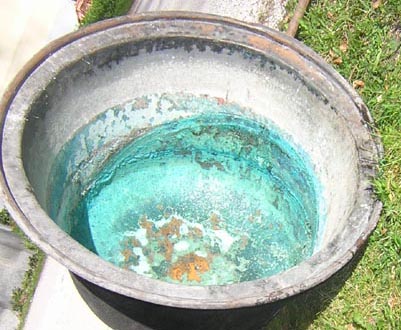Isn’t copper too soft?
Pure copper is too soft.
A solid alloy, the even higher quality BRONZE, is used for our garden tools.
At least 92% copper + tin = BRONZE. This alloy is compacted (forged) with a forging hammer to further improve its hardness.
Answer from Johannes Stadler
Why copper instead of iron? …..see also > PREFERENCES
The effect of metals in the soil
In nature, metals are usually found in balanced doses and in a chemical compound that is neutral for the soil. However, according to Viktor Schauberger’s observations, those areas where there is a lot of iron ore tend to be barren areas.
[show_more more=”weiterlesen” less=”weniger”]
In contrast, copper-rich landscapes are characterized by lush growth. He also shows that the conspicuous decline in yields in Bulgarian agriculture after “modernization” is due to the rather barren areas that now exist wherever there is a lot of iron ore. In contrast, copper-rich landscapes are characterized by lush growth. He also shows that the conspicuous decline in yields in Bulgarian agriculture after “modernization” was due to the steel ploughs that were now used everywhere. In the scattered Turkish settlements, where there were still the old (customary) wooden plows, most of which were pulled by people, he recorded no decline in yields. The steel plows were also pulled by horses and sometimes also by steam power, so that more abrasion and, of course, heat was generated due to higher resistance. To prove his findings, Viktor Schauberger put iron fines in water; rust immediately forms and the water loses its natural tension. In the soil, especially as its specific gravity is increased, it will tend to sink and be almost inaccessible to plant roots! Further negative effects on the water balance of the soil caused by fast-moving iron and steel ploughs are the build-up of heat, which causes water to evaporate, and the electrolytic effect, which decomposes the water into hydrogen and oxygen, both of which volatilize. The soil dries out. All this reduces the geospheric tension, growth is inhibited and yields decline. These findings were not well received by the government at the time, as business interests were paramount.
However, it is precisely the iron that has a negative effect on the soil when it passes through and through abrasion. The advantage of copper is its non-magnetic property, so that no electric currents are generated when it passes through the soil. It should be mentioned that practitioners who work with copper implements (plows, hoes) have found that copper implements offer much less resistance to the soil than iron implements. It is easier to work! Copper does not rust, so there is no oxidation with copper or precious metals. This preserves the water. Viktor Schauberger sees iron as a hydrogen robber and copper as a hydrogen producer! We can check this for ourselves if we put an iron object on our tongue; it is not pleasant. When copper is worn away, copper, tin and possibly other traces of precious metals are finely distributed in the soil. It is therefore a trace element fertilization for the soil.
[/show_more]
Answer from Jakobus Langerhorst
What is the difference between verdigris and patina?
To answer your question, I would like to expand a little and clear up a widespread confusion of terms:
The patina is sometimes referred to colloquially as called “verdigris”. This term is incorrect!
Verdigris is a water-soluble salt of acetic acid in combination with copper and is often mistaken for patina due to its color. However, due to its solubility in water, it can never take over the protective function and does not occur in the garden due to the lack of acetic acid.
The natural brown or green top layer on copper surfaces consists mainly of non-toxic Cu(I) oxide and must not be confused with verdigris. See also > verdigris or patina.
In short: none of the visible green copper surfaces in the outdoor area really show verdigris, but rather patina or other non-toxic copper compounds.
Answer from Dipl.-Ing. M. Werner – Deutsches Kupferinstitut e.V.
Hammer a copper nail into a tree so that it dies. Is that true?
The legend that hammering a copper nail into a tree will cause it to die is still untrue. It does not work, not even with a dozen nails. Copper is a vital trace element, also for animals and plants, and is therefore also used in fertilizers and animal feed. Of course, there are plant species that are somewhat more sensitive to the trace element copper and would show a certain degree of scarring with such “nail treatments”. However, the causes for the death of a tree are always to be found elsewhere.
Answer from Dipl.-Ing. M. Werner – Deutsches Kupferinstitut e.V.
When I activated my rake in spring, it had a green discoloration?

The screen definitely does not show any verdigris; this green coloration is an oxidation product that occurs on copper surfaces in a damp environment. This coloration is not critical in any respect, i.e. not important if it does not bother the owner for visual reasons. Otherwise, brass wire brushes, plastic fleece or cleaning fluids (see below) can be used for cleaning.

The boiler contained a liquid that reacted with copper. Only if this liquid was acetic acid, [show_more more=”weiterlesen” less=”weniger”]verdigris could have developed. In this case, however, the dyeing products would have been water-soluble and thus also removed when the kettle was emptied. I suspect that the kettle contained alkaline substances that acted over a longer period of time and caused this blue-green coloration:
These products consist mainly of carbonates of copper, potassium and sodium, with varying silicate content. They are non-toxic. The cause is leaching from fresh mortar, plaster and concrete slabs during the setting process, possibly also from gravel fills (was the boiler also in the damp room, e.g. to catch the leakage in the concrete ceiling?) Alkaline cleaning agents may also be involved. As alkaline leaching subsides, new blue-green oxidation products no longer form on the copper surface. However, as they do not disappear by themselves, brushing with a stainless steel or brass wire brush and rinsing with water is recommended. Finer soiling can be removed with Protall special, for example.
The discolorations do not reappear afterwards for the reasons described.
After cleaning the boiler, you will see very clearly that the surface of the material has not been affected by these leaching products: the bright copper reappears. This is a clear indication that these washouts have not damaged the material, but merely impaired the decorative appearance of the copper.
Answer from Dipl.-Ing. M. Werner – Deutsches Kupferinstitut e.V. [/show_more]
Is rainwater from copper gutters good for watering the garden?
Rainwater that has run over copper gutters contains extremely few copper ions due to the short dwell time in the gutter and can therefore be used in the same way as rainwater from other gutters. Of course, regardless of the gutter material, the consumer should be aware that this collected rainwater contains impurities from deposits on the roof surface, dust, bird droppings, etc. and that these substances could have an impact on their plants.
Answer from Dipl.-Ing. M. Werner – Deutsches Kupferinstitut e.V.
Can the use of EM (effective microorganisms) produce verdigris in the garden soil?
The use of copper garden tools causes abrasion, which has a very positive effect on the garden soil and its plants. In this context, the question arose as to whether the copper fines could develop verdigris in combination with an EM fertilizer.
Over time, copper forms compounds with various substances, usually forming basic copper carbonates. These compounds are usually green or bluish in color and form a water-insoluble protective layer (patina). Examples of this are the initially brown, later green copper roofs of many churches – some people mistakenly refer to this as verdigris. The natural brown or green top layer on copper surfaces consists mainly of non-toxic Cu(I) oxide and should not be confused with verdigris.
Verdigris, on the other hand, is exclusively the water-soluble product of copper with acetic acid.
The term verdigris is therefore incorrect in this context. Due to its solubility in water, verdigris can never assume the protective function, but in the absence of acetic acid it is also irrelevant in your case.
Dr. KLAUS OCKENFELD
Environment and Health
Environment & Health
German Copper Institute
Berufsverband e.V.
Am Bonneshof 5
40474 Düsseldorf
Tel.: 0049(0)211-4796324
Fax: 0049(0)211-4796310
www.kupferinstitut.de